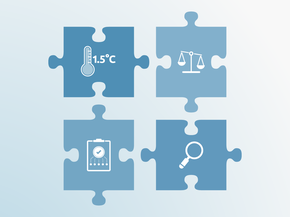Country summary
Assessment
The European Union’s climate and energy policy developments during 2018 and early 2019 are steps in the right direction towards re-establishing its position as a global leader on climate policy action. For this purpose, however, the EU also needs to radically increase the emissions reduction goal in its Paris Agreement commitment (NDC) to reflect not only the policies it has already adopted, but also what it can achieve by 2030.
The 2018 renewable energy and energy efficiency goals would result in emissions reductions of around 48% by 2030: in its NDC, the EU committed to emissions reductions of “at least 40%”. Yet a recent study by Sandbag shows that various national coal phase-out plans, combined with closing coal power in the remaining EU member states by 2030, and increasing the energy efficiency goal from 32.5% to 40%, would result in emissions reductions of 58% by 2030. The European Parliament and a number of EU member states have already called for increasing the 2030 target to a 55% reduction, which would be a significant improvement but not yet enough to reach the boundary of a 2°C compatible reduction range.
The reform of the EU ETS finalised in 2018 has already resulted in higher priced allowances. As at least half of the EU ETS allowance auction proceeds from their sale must be spent on climate action, which has increased resources available for low-carbon measures. The adoption of eight pieces of legislation in the “Clean Energy for all Europeans” package in 2018 and early 2019 has created a framework for the decarbonisation of the energy and buildings sectors by the middle of the century. New emissions reduction goals for passenger cars, as well as light- and heavy-duty vehicles – if effectively implemented – will address increasing emissions from the transport sector.
In November 2018, the Commission presented a draft of the EU’s long-term strategy, with an assessment of emissions reduction scenarios for 2050. Its final version adopted by the Council should reflect a clear commitment by the EU and its all member states to emissions neutrality by, latest, mid-century, while also increasing its 2030 emissions reduction goal.
Whilst the EU’s emissions increased by 0.6% in 2017, preliminary numbers for 2018 show emissions from the combustion of fossil fuels decreased by 2.5% which is positive.
However it remains the case that in some sectors the EU still lags behind other countries or what is needed to the Paris Agreement temperature goal: in terms of electrifying its transport sector lags behind other countries an even the global average, and the rate of renovation in the building sector is far from what’s needed.
To accelerate decarbonisation – especially in the transport and building sectors – legislation must be efficiently and effectively implemented. Whereas it is up to car manufacturers to find ways to achieve new emissions standards and quotas for zero and low emissions vehicles, national governments need to create a conducive framework for facilitating this process.
Member states and local public authorities also need to promote modal shift by investing in improved public transport and expand rail infrastructure. Implementation of best case practices in the building sector, introducing a pan-European ban on installing oil, gas and coal heating in new builds, flanked with support for low-carbon and zero carbon alternatives such as heat pumps, would not only result in emissions reductions, but would also reduce Europeans’ energy bills and promote the EU’s energy security.
Some of the funds to achieve the above-mentioned goals could come from shifting resources being used for natural gas infrastructure. While overall gas consumption decreased by 1.8% in 2018, some EU member states are increasing their support for the development of gas infrastructure that will increase EU dependency on energy imports, undermine energy security, lead to stranded assets, and jeopardise meeting the Paris Agreement goals.


The EU is on-track to meeting this NDC and, if it implements current targets in place, may achieve 48% by 2030.
In 2018 two thirds of emissions in the EU’s power sector still came from coal-fired power plants. But the role of coal is falling: between 2017 and 2018 emissions from hard coal fell by 9% and from lignite by 4%. This decrease was compensated by renewables, the share of which increased from 30% in 2017 to 32% in 2018.
In the last six months Finland and the Netherlands have accelerated their coal phase-out from 2030 to 2029 and the Austrian Minister of Environment has announced a coal phase-out by 2020 instead of 2025. Germany’s “Coal Commission” called for the closure of the last coal plant by 2038. However, there’s still no sign of any legislation to bring that into effect. A coal phase-out is currently being discussed in Spain, Slovakia and Hungary.
In Poland, the Government still plans to build a new coal-fired plant, but it’s expected to generate a loss, and would only be possible with subsidies that are still allowed under the EU ETS until the end of 2019. A new political party is calling for a coal phase-out by 2035.
The reform of the 2018 EU ETS, combined with higher price of allowances, will incentivise investment into energy efficiency in industry.Some of those investments can be implemented using the resources from the Innovation Fund which must be spent on “industrial innovation in low-carbon technologies and processes”.
Between 2016 and 2017, emissions from the transport sector increased by 1.6%, reflecting the continuation of a troubling trend that has resulted in emissions growth of around 28% above 1990 levels. The fastest increase has been in aviation, which more than doubled in this period. As a result, budget airline Ryanair joined the list of the EU’s ten biggest greenhouse gas emitters. Notably, the EU sustainable transport strategy has not been updated since 2009. The European Investment Bank’s transport policy dates from 2011. Both will require updating to address the current emissions growth trend.
The 2018 Renewable Energy Directive (REDII) introduced a new goal of a 14% share of renewables in the transport sector by 2030. This target has been flanked by limiting the share of first-generation biofuels. Uncertified biofuels that may create the risk of high indirect land-use change emissions cannot be counted toward meeting the 2030 target. The directive encourages use of energy from second-generation biofuels and electricity.
In December 2018 the European Parliament and the Council agreed on a regulation with the goal of reducing CO2emissions from new passenger cars and vans, with 2030 goals and an intermediary improvement date. In February 2019 European Parliament and the Council agreed on emissions standards for heavy duty vehicles.
Support for low carbon modes of transport in some member states has led to an increase in the sale of electrically-chargeable vehicles in the first half of 2018 to over 300,000 vehicles of all new passenger cars sold in the EU. However, the share varies strongly by country, with Sweden, the Netherlands and Finland making the most progress. Some EU member states have already announced plans to ban the sale of combustion cars in the coming decades, e.g. Denmark and the Netherlands by 2030, and the United Kingdom and France by 2040.
The EU will need to take much more decisive action to meet a Paris Agreement-compatible emissions trajectory in its switch to electric vehicles. This may also have positive income on the EU’s economy: In 2018, the EU’s trade surplus from exporting electric and hybrid electric cars amounted to €3 billion, mainly from Germany, Sweden and the UK.
Underdeveloped charging infrastructure remains a major hindrance to the uptake of electric vehicles. New directives, combined with additional funding from both national and European sources, has led to a significant increase in the number of charging points, from 59,200 in 2015 to 151,700 in 2019.
The EU’s new Energy Performance in Buildings Directive (EPBD), adopted in 2018 obliged each member state to submit a long-term renovation strategy leading to fully decarbonising its building stock by 2050. It remains to be seen whether this will help address the issue of the low rate of deep renovation of the existing building stock. An increase of the renovation rate to 5% would be necessary to make emissions from the building sector compatible with the 1.5°C temperature increase limit.
Since 35% of the EU’s building stock is over 50 years old and much of the overall lifetime reaches beyond 100 years, increasing the renovation rate could significantly reduce energy consumption and emissions. Much more effective has been European legislation dealing with the energy efficiency of household appliances.
Further analysis
Latest publications
Stay informed
Subscribe to our newsletter






